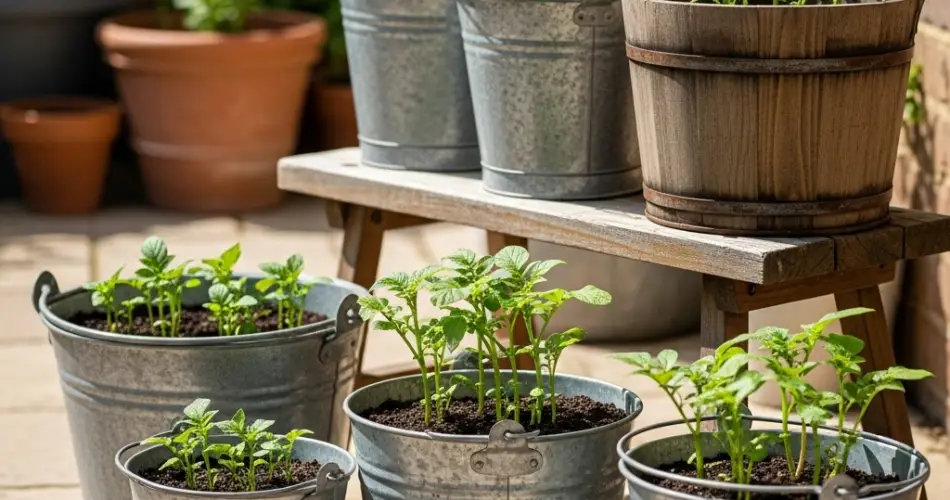Potatoes are a versatile and rewarding vegetable to grow at home, and they adapt well to container gardening. Growing potatoes in buckets is an excellent option for gardeners with limited space, such as balconies, patios, or small yards. With the right container, soil, and care, you can enjoy a fresh supply of homegrown potatoes throughout the season. This guide provides step-by-step instructions for planting and maintaining potatoes in buckets.
Choosing the Right Bucket
Select a bucket or container that is at least 12 to 16 inches deep to accommodate potato tubers as they grow. A wider container allows you to plant multiple potatoes at once. Ensure your bucket has drainage holes to prevent waterlogging, which can lead to rot and poor tuber development. Common options include large plastic buckets, wooden barrels, or repurposed containers, as long as they provide sufficient depth and drainage.
Selecting Seed Potatoes
Start with certified seed potatoes rather than store-bought varieties, as they are less likely to carry diseases. Seed potatoes are small tubers or pieces of larger tubers with at least one or two “eyes” or sprouts. Cut larger seed potatoes into pieces about 1.5 to 2 inches in size, ensuring each piece has at least one eye. Allow the cut pieces to dry for a day or two to form a callus, which helps prevent rot when planted.
Preparing the Soil
Potatoes grow best in loose, well-draining soil. A mixture of garden soil, compost, and sand or perlite provides an ideal environment for tuber growth. Avoid heavy clay soils that can compact and restrict tuber expansion. Adding compost or a balanced organic fertilizer enriches the soil with nutrients, promoting healthy foliage and tubers. A recommended mix is 2 parts soil, 1 part compost, and 1 part sand or perlite.
Planting Potatoes in Buckets
-
Fill the bucket with 4 to 6 inches of the prepared soil mix.
-
Place the seed potatoes on top of the soil, eyes facing upward.
-
Cover the potatoes with 3 to 4 inches of soil.
-
Water gently to settle the soil without washing away the tubers.
As the potato plants grow, you will add more soil, a process called “hilling,” which encourages tuber formation along the buried stems.
Sunlight and Placement
Potatoes need full sun for optimal growth. Place your bucket in a location that receives at least 6 hours of direct sunlight daily. Insufficient sunlight can slow growth, reduce yields, and result in smaller tubers. Adequate light ensures robust foliage and abundant potato development.
Watering and Care
Consistent moisture is critical for container-grown potatoes. Water regularly to keep the soil evenly moist, especially during tuber formation. Avoid waterlogging, as it can cause rot, and prevent the soil from drying out completely, which can lead to tough, fibrous potatoes. Mulching the soil surface with straw or shredded leaves helps retain moisture and keeps the soil cool.
Hilling Potatoes
As potato plants grow, continue adding soil to cover the lower stems, leaving the top few inches of foliage exposed. Repeat this process every few weeks or when plants reach 6 to 8 inches tall. Hilling prevents tubers from being exposed to sunlight, which can turn them green and toxic, and encourages the growth of more potatoes along the stems.
Fertilizing
Feed your potato plants with a balanced organic fertilizer every 3 to 4 weeks. Fertilizers rich in potassium and phosphorus promote tuber development, while excessive nitrogen can lead to lush foliage but few potatoes. Follow package instructions or use compost teas for gentle, nutrient-rich feeding.
Pests and Disease Management
Container-grown potatoes can attract pests such as aphids, Colorado potato beetles, and wireworms. Inspect plants regularly and remove pests manually or use organic insecticidal solutions if necessary. Good airflow and proper watering reduce the risk of fungal diseases such as blight or powdery mildew.
Harvesting Potatoes
New potatoes can be harvested about 10 weeks after planting, once plants flower. For mature potatoes, wait until the foliage turns yellow and begins to die back, usually 12 to 16 weeks after planting. Gently dig into the soil to retrieve the tubers, being careful not to damage them. Let potatoes cure in a cool, dark place for a few days before storing.
Final Tips
Growing potatoes in buckets is a rewarding way to enjoy fresh, homegrown tubers even in limited spaces. Choosing the right container, using nutrient-rich soil, providing adequate sunlight and water, and practicing regular hilling are key to a successful harvest. With proper care, container-grown potatoes can yield a bountiful crop, perfect for cooking, baking, or roasting straight from your garden.



